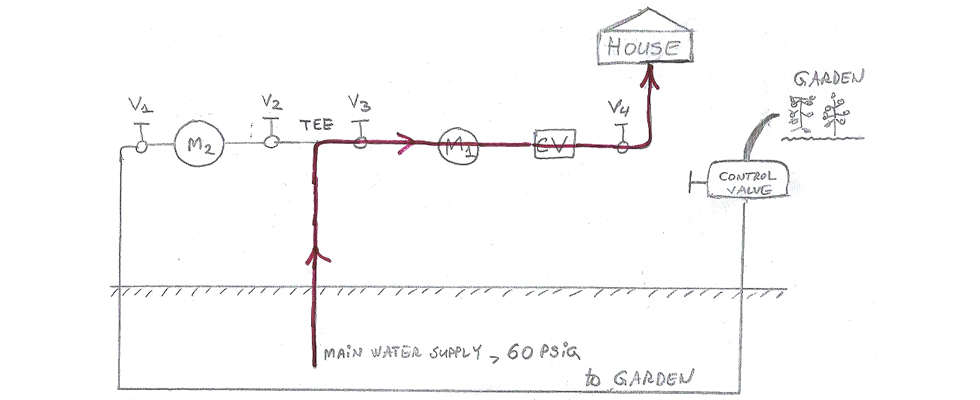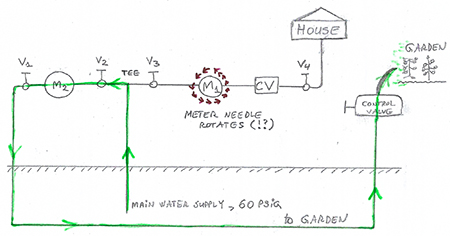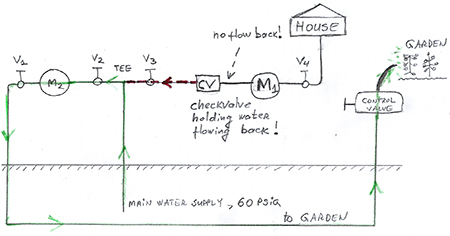
Having received several comments on my March column’s garden watering water metering puzzle, I would like to share two such comments from our readers. I had prepared a solution write-up, but instead I will use these emails, as they beat my planned follow-up:

BRIAN:
Interesting situation. There could be a couple of items going on here.
One could just be “flowing-induced” vibration causing the house meter to jiggle and show a false flow.
Secondly, it is probably more complicated. It wasn’t detailed just how much meter M1 was moving or if it was constant or intermittent. It is possible pressure variations caused by the garden watering control are forcing water through M1 into the house where a pulsation dampener is taking in water. Then, when the pressure drops, the pulsation dampener is pushing the water backward through M1 (which I assume only measures flow in one direction). A check valve installed between V3 and M1 should alleviate this problem, or a pulsation dampener could be installed at the tree to catch the pressure pulses before they migrate through M1.
Just a couple of thoughts. Hopefully, they may explain or solve the problem. Will be interesting to see the true answer next month.
Brian A. Meister
Engineering Technologist III
Duke Energy

MARK:
Hi Dr. Nelik,
I thought I would put my “two cents” in on this question.
I believe that when the garden is being watered, the flow rate is so high that the “head” pressure from the house is sufficient to overcome the supply pressure because of the pressure drop. The house leaks back through the “house” meter or even possibly educted. There was no mention in your description if the house water consumers were being used simultaneously or not, whether the house meter was moving the entire time the garden was being watered or if the meter movement was intermittent. If the house was experiencing some performance issues, e.g. low flow, low pressure or no flow, especially on the second floor, it would be a good clue as to what might be happening. I recognize
that in my scenario the CV leaks sufficiently in the wrong direction as well.
A quick check of this theory would be to close the valve downstream of the meter and see if the meter continues to move. If the meter continues to move with the house completely isolated, perhaps the turbulence in the supply to the house meter section was causing the meter to rotate.
Best regards,
Mark Wertheimer, Marine Engineer

DR. PUMP:
Regarding Mark’s point: When I was first introduced to this problem, I asked the technician to close the auxiliary water valve inside the house (Image 3, not shown on the illustration in the March article). Once closed, he then activated the garden valve and the same thing happened. The meter showed flow, as it had in earlier times, for a few seconds before stopping. This told me there was no backflow from the house, as the inside valve now did not allow it, and thus I ruled out the “house effect.” When the house consumed water, the garden route was not operational and vice versa.
The reason why the meter shows flow is because when the garden valve actuates, there is a brief drop in pressure past the tee due to water movement from stop. The fluid in the short part of the breach (between the check valve and the tee moving toward the garden piping) also joined with the incoming flow from the main.
Once the transient stops and the pressure equalizes (let’s say from the drop to 55 pounds per square inch [psi] back to 60 psi of the main), the movement of water in that part of the branch is no longer taking place, and the meter gradually slows down and stops.
And so, as you pointed out, if the meter M1 and check valve were simply swapped, there would be no way for water to pass through the meter. The check valve would stop it immediately.


